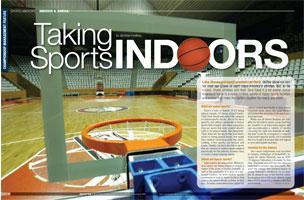
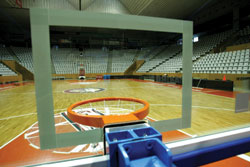 Like those intrepid postal carriers, neither snow nor rain nor heat nor gloom of night stays America's athletes. But, to be honest, those athletes and their fans have it a bit easier, since America is home to a nearly endless variety of indoor sports facilities and arenas that make the perfect location for nearly any event.
Like those intrepid postal carriers, neither snow nor rain nor heat nor gloom of night stays America's athletes. But, to be honest, those athletes and their fans have it a bit easier, since America is home to a nearly endless variety of indoor sports facilities and arenas that make the perfect location for nearly any event.
What are indoor sports?
Here's a rule of thumb: If it's being played outside, it's being played inside. That's how broad and varied the category of indoor sports can be. But to be more specific, the athletic multitude of indoor sports falls roughly into three categories. First are sports that were created specifically to be played inside, like basketball. Then, there are the sports that lend themselves to being played inside, but might have outdoor versions as well, like cheerleading, roller sports, ice hockey and karate. Finally, you have the indoor sports that are versions of outdoor sports adapted specifically for the indoors, in many cases to create a longer playing season.
Where are indoor sports?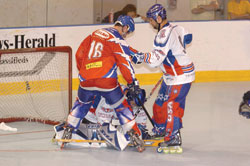 Indoor sports are everywhere. Which indoor sports are being played is simply a matter of the arena or facility available, as well as the popularity of a sport in a particular location. As with outdoor sports, communities tend to build facilities that support the sports already popular in their area. So some communities have indoor facilities created specifically to host indoor volleyball while others have giant basketball arenas that are home to the area's professional team.
Indoor sports are everywhere. Which indoor sports are being played is simply a matter of the arena or facility available, as well as the popularity of a sport in a particular location. As with outdoor sports, communities tend to build facilities that support the sports already popular in their area. So some communities have indoor facilities created specifically to host indoor volleyball while others have giant basketball arenas that are home to the area's professional team.
While not all indoor facilities are suitable for all indoor sports, most facilities are versatile to at least some degree and can accommodate a variety of sports. Choosing the right one depends on making sure it can be configured to support your event's specific needs, not to mention that it is located in an area that will appeal to your participants and fans.
Invented for the Indoors
The lowest temperature ever recorded in Ontario, birthplace of basketball's inventor Dr. James Naismith, was in 1935: -72 degrees Fahrenheit. Of course, by that time, Naismith was well into his career as basketball's inventor and first coach. But given the climate that featured largely in young Naismith's childhood, it's no wonder he adapted one of his favorite childhood games into a full-scale athletic event that could be played in a climate controlled environment.
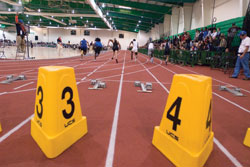 After attending and later serving as athletic director at Montreal's McGill University, Naismith headed to the YMCA Training School in Springfield, Massachusetts, where he brought basketball to life.
After attending and later serving as athletic director at Montreal's McGill University, Naismith headed to the YMCA Training School in Springfield, Massachusetts, where he brought basketball to life.
The sport has certainly grown beyond anything its creator could have envisioned. And while basketball is now played outdoors as well, it is still primarily an indoor sport, played in small spaces, large spaces, and in some cases, like Portland, Oregon's Rose Garden Arena, awe-inspiring spaces.
After a 34-year dry spell, the NCAA returned to Portland's $262 million, 20,000-seat multipurpose venue after the Oregon Sports Authority lobbied the state's legislature to remove the state's exception to the federal rule against legalized sports gambling, which violated NCAA regulations. With the exception removed, the NCAA Division I Basketball Committee was free to take advantage of everything Portland offers, including the Rose Garden, and chose the city for its 2009 NCAA Division I Men's Basketball Championship first- and second-round games.
"We'd gotten a bill passed for major league baseball funding and had some experience being at the legislature, so when we realized this was the opportunity to get something done that would clearly result in us getting the tournament, we got to work," said Meyer Freeman, chief operating officer, Oregon Sports Authority. "We knew the Rose Garden would make the perfect venue, and it was a great event with sell-out crowds."
Roller Sports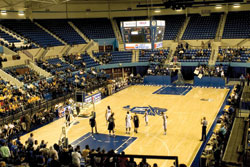 Although not technically invented primarily to be an indoor sport, roller sports have evolved to take place largely indoors. And a particular roller sport - roller derby - has recently captured America's attention, drawing huge crowds and big dollars to communities that host the events.
Although not technically invented primarily to be an indoor sport, roller sports have evolved to take place largely indoors. And a particular roller sport - roller derby - has recently captured America's attention, drawing huge crowds and big dollars to communities that host the events.
Unlike most sports, which each have their own national governing body (NGB), all roller sports, including figure skating, speed skating, inline and traditional roller hockey and roller derby, are governed by U.S. Roller Sports. Typically roller sports events are held in facilities specifically made for roller skating, but derbies are held in auditoriums or convention centers, due to the need for more space. That means that any community with a roller rink or convention center can get in on this growing trend.
"Overall we've seen a participation increase in all our disciplines in the last couple of years, mostly due to the popularity of roller derby," says Richard J. Hawkins, executive director, USA Roller Sports. "We typically see an increase around the Olympics, particularly recently, since some of the Olympic champions, like Chad Hedrick and Apolo Ohno, came from roller sports before switching over to ice."
One of the organization's longtime partners is Pershing Auditorium, a historic, 7,000-seat arena in downtown Lincoln, Nebraska, USA Roller Sports' hometown. But when destination shopping for out-of-town non-rink events, such as roller derby or championships, USA Roller Sports looks for a location with a venue that is large enough to put in its traveling skating floor, which is 84 by 184 feet - twice as large as a basketball court. Like other sports planners, they also look for a location that has a good selection of nearby hotels, restaurants and attractions that will appeal to families, who often turn roller sports competitions into their family vacations.
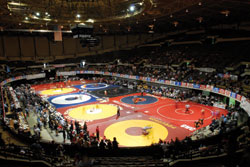 Currently, the Pan American Games are roller sports' highest international competition, but they are one of seven sports being considered for Olympic inclusion. The Olympic Committee will announce their decision this October.
Currently, the Pan American Games are roller sports' highest international competition, but they are one of seven sports being considered for Olympic inclusion. The Olympic Committee will announce their decision this October.
Sports for the Great Indoors
In some cases, sports can be played outside, and often are, but indoor venues just suit them better, particularly in the case of tournaments and competitions. These sports, like cheerleading, dance, karate, volleyball, even shooting, find homes in a variety of locations all over the country.
South Sioux City, Nebraska
The Cobra Indoor Sports Arena and Dome in South Sioux City, Nebraska, is just such a location. The facility was originally an indoor driving range, but the recently renovated 44,000 square-foot facility now hosts a range of events.
"Volleyball is going to be our primary sport, but depending on the volleyball tournament schedule, we're going to also play indoor soccer and softball in the winter, and offer an indoor driving range and batting cage," says Jim Ewoldt, co-owner of the Cobra.
The Cobra can accommodate eight volleyball courts simultaneously, with plenty of space between courts, an unusual and coveted feature for most volleyball tournaments. Last winter, the venue's first season after renovations, the Cobra hosted six tournaments and anticipates doubling that number this year.
Butler County, Ohio
Volleyball, basketball and a variety of other indoor sports flock to Miami University's Millet Hall.
"One of the greatest assets we have in our county is Miami University in Oxford," says Stephanie Gigliotti, sales manager, Butler County Convention and Visitors Bureau. "They have incredible facilities, and we work together to bring in events and support them."
Long Island, New York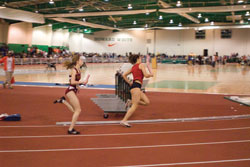 Swimming is another event that is often better suited, at least competitively, to a climate controlled facility. While outdoor aquatics facilities abound in some of the sunnier areas of America, Long Island, New York is home to one of America's premier indoor aquatics facilities, the Nassau County Aquatics Center. Rated one of America's top 10 aquatics facilities, the Center hosted Michael Phelps and the U.S. team in competition against some of the world's best swimmers in the 2006 FINA World Cup.
Swimming is another event that is often better suited, at least competitively, to a climate controlled facility. While outdoor aquatics facilities abound in some of the sunnier areas of America, Long Island, New York is home to one of America's premier indoor aquatics facilities, the Nassau County Aquatics Center. Rated one of America's top 10 aquatics facilities, the Center hosted Michael Phelps and the U.S. team in competition against some of the world's best swimmers in the 2006 FINA World Cup.
Hampton, Virginia
No matter what your indoor sport, Hampton, Virginia has it covered. With a plethora of indoor sports facilities, including the Hampton Roads Convention Center, the Hampton Coliseum, the Hampton University Convocation Center and the new Boo Williams Indoor Arena, just to name a few, Hampton Roads hosts a huge variety of indoor sports all year long.
"We're very fortunate to have four premiere facilities, and we can customize a facility package that's going to meet just about any RFP need," says Kris Smith, sports group sales manager, Hampton Convention and Visitors Bureau.
Hampton's newest indoor facility, the Boo Williams Sport Complex, a 135,000 square foot indoor sports and event center, opened its doors in March 2008. Specially designed for amateur athletic competitions, the facility contains eight hardwood basketball courts, a six-lane indoor track, 4,000 spectator seats and can be converted to accommodate basically any indoor sport.
Greater Grand Island, Nebraska
In Greater Grand Island, Nebraska, even the shooting competitions come indoors. The area's 170,000 square foot Heartland Event Center plays host to the national 4-H shooting championships, and two of the events, the air rifle and air pistol competitions, must be held in a climate controlled facility. But that's just one of countless sports this facility can and has hosted, and the sports complex surrounding it is growing by $42 million.
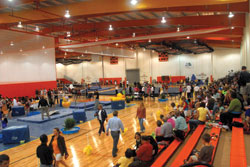 "We're doing a lot of exciting construction," says Renee Seifert, executive director, Greater Grand Island Nebraska Sports Council. "The largest new building will be a combo building, part of our new state fair complex - an arena with large ancillary buildings on each side. So for example, a rodeo could have stalls in two adjacent under-roof areas."
"We're doing a lot of exciting construction," says Renee Seifert, executive director, Greater Grand Island Nebraska Sports Council. "The largest new building will be a combo building, part of our new state fair complex - an arena with large ancillary buildings on each side. So for example, a rodeo could have stalls in two adjacent under-roof areas."
Beaumont, Texas
Rodeos, bull riding and pretty much any other sport, have the freedom of going inside at the Ford Park Event Center in Beaumont, Texas. Home to five different sports facilities, Ford Park offers the 8,500-seat multi-purpose Ford Arena for indoor events.
In May, the Ford Arena hosted the 61st Annual Young Men's Business League Championship Rodeo, where more than 300 top-ranked cowboys from the Professional Rodeo Cowboys Association wrangled for $19,000 in prize money in bull-riding, steer wrestling, tie-down roping, saddle bronc, bareback riding and team roping events.
The Outside Comes In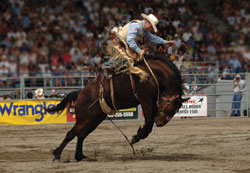 Rodeos, traditionally outdoor sports, are just one of many outdoor sports that head inside for at least part of the season. Soccer, softball, field hockey and lacrosse all have indoor cousins. Most of these indoor versions began as ways to extend the season in cold weather but some like indoor or "box" lacrosse, have become year-round sports in their own right.
Rodeos, traditionally outdoor sports, are just one of many outdoor sports that head inside for at least part of the season. Soccer, softball, field hockey and lacrosse all have indoor cousins. Most of these indoor versions began as ways to extend the season in cold weather but some like indoor or "box" lacrosse, have become year-round sports in their own right.
Williamsport, Virginia
At the Generation Sports Complex Dome (GSC Dome) in Williamsport, Pennsylvania, sports like soccer, softball and lacrosse find a magnificent winter home. Constructed in 2006, the GSC Dome is the largest fully air-supported dome in the country, offering 135,000 square feet equipped for field sports, training, tournaments, leagues and special events.
"We do a lot of practices, scrimmages and tournaments during the winter, which is a bad time for a lot of outdoor sports in this part of the country," says Dan Johnson, program director, GSC Dome. "There's not a better facility in the northeast for sports in the winter."
One indoor sport, arena football, that got considerable attention when its professional league began in the late ‘80s and again recently when its professional league suspended play for a season to reorganize. Based on American football, arena football is played indoors on a smaller field, resulting in faster, higher-scoring and, some feel, more exciting, play. The Arena Football League plans to resume play in 2010.
Innovation Inside
Indoor sports have unlimited potential for making it possible to play - in just about any sport imaginable - all year long. And as more facilities are built and renovated, the options for hosting your next indoor event are almost infinite. So, don't limit your season or your imagination. Just find an indoor facility that fits your event, and hit the field!

